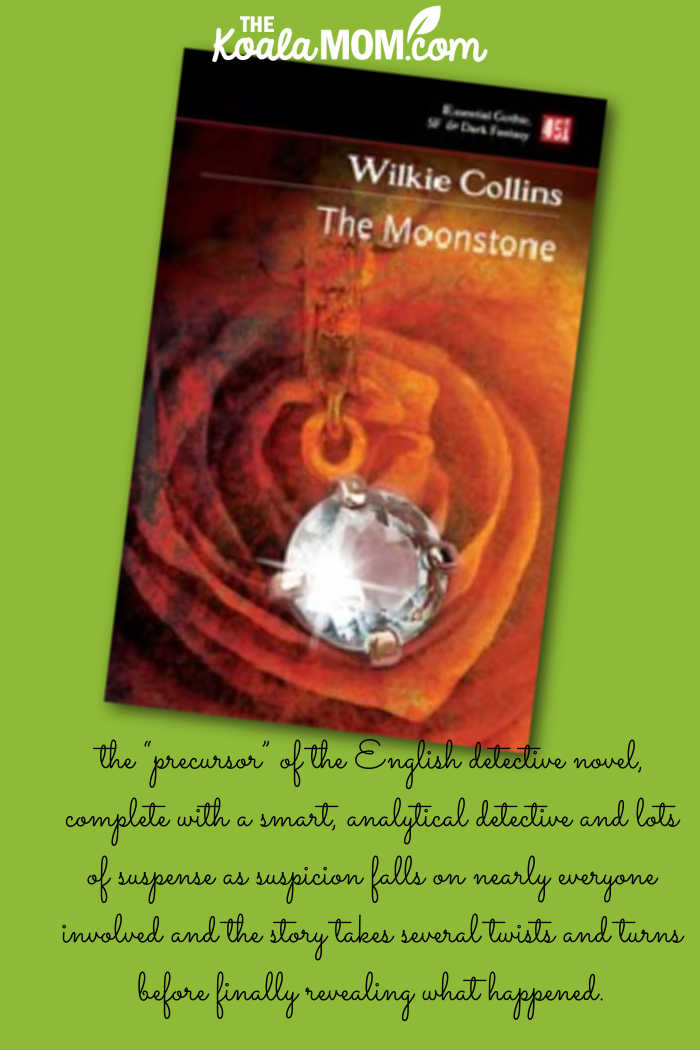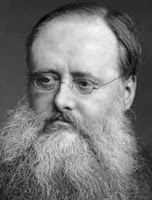Wilkie Collins’ novel The Moonstone is a detective story about a jewel, originally looted from a shrine in India, which disappears after being given to Rachel for her birthday.
One reviewer called The Moonstone the “precursor” of the English detective novel, complete with a smart, analytical detective in the person of Sergeant Cuff, and lots of suspense as suspicion falls on nearly everyone involved and the story takes several twists and turns before finally revealing what happened.

This post contains affiliate links; as an Amazon associate, I earn from qualifying purchases.
What happens in The Moonstone
What I found most intriguing about the novel was Collins’ use of several first person narrators. The story is told directly from the perspective of the people involved in the mystery, complete with their unique opinions, viewpoints, and ideas regarding everything going on. Collins’ characterization and psychological insight are brilliant. This style also draws the reader in as a sort of detective themselves, trying to decipher who is a reliable narrator and who is not, and what really happened:
…we must piece together the truth of what happened incrementally from what each character reveals. This narrative style resembles epistolary fiction, when a story is told in letters, a form that became popular in the eighteenth century. … The Moonstone is mostly made up of narratives written explicitly for the purpose of solving the crime after the fact – although the prologue frames this collection of testimonies with a single voice! Using these multiple documents, Collins offers a twist to the epistolary form to suit the emerging detective genre.
 The first narrator is Betteredge, the household steward, who holds that we should be “superior to reason” and that a pipe and Robinson Crusoe are good for whatever bothers you. We then pass into the hands of Miss Crabb, a pious spinster who belongs to the Mothers-Small-Clothes-Conversion-Society and hands out tracts and religious books to everyone and anyone. Franklin Blake is narrating the story when the suspicion of stealing the diamond falls on him, causing greater confusion over the “whodunit” since, being inside Franklin’s head, we believe his professions of innocence and are as confused as he is about the theft.
The first narrator is Betteredge, the household steward, who holds that we should be “superior to reason” and that a pipe and Robinson Crusoe are good for whatever bothers you. We then pass into the hands of Miss Crabb, a pious spinster who belongs to the Mothers-Small-Clothes-Conversion-Society and hands out tracts and religious books to everyone and anyone. Franklin Blake is narrating the story when the suspicion of stealing the diamond falls on him, causing greater confusion over the “whodunit” since, being inside Franklin’s head, we believe his professions of innocence and are as confused as he is about the theft.
Other people involved in the novel provide long or short passages relating to the diamond, each in their own style, from lawyer Bruff’s matter-of-fact report to doctor Ezra’s opium-influenced ramblings. From each narrator, we learn more about the events of the story and the other narrators and eventually put together the story of the jewel.
The plot with its hairpin twists held my interest and invited me to happily suspend disbelief, but it did not overwhelm the characters. The heroine, Rachel Verinder, complicated and stubborn, is unlike the ‘legless angels’ popular in Victorian literature. The dilemmas she faces remain significant today: Should we marry where our passions lead us, or choose a life partner whose values are compatible with ours? If the person we love turns out to be a criminal, should we turn him in or allow someone else to be blamed? ~ Author Chitra Divakaruni
 More about Wilkie Collins
More about Wilkie Collins
Wilkie Collins was born in 1824 and lived only sixty-five years. He wrote thirty novels, more than sixty short stories, at least fourteen plays, and more than one hundred nonfiction pieces. He and Charles Dickens were good friends, and he often contributed to Dickens’ magazine Household Words. His most popular novels today are The Moonstone and The Woman in White (also an excellent novel). For more about Wilkie, see his biography. His books are available on Amazon, Bookshop.org, and your local bookstore or library.
If you want to know more about Wilkie’s other books, check out Nicole’s ranking at Noteworthy Fiction! If you’ve read Wilkie’s other works, do you agree with her assessment? Or which Wilkie novel do you want to read next?
If you enjoyed The Moonstone, you may also like:

No Responses Yet